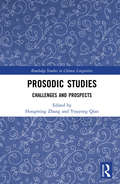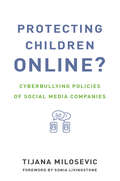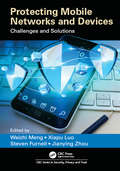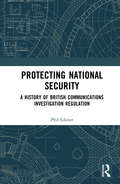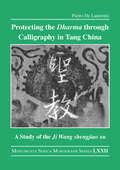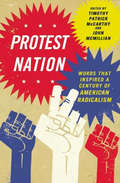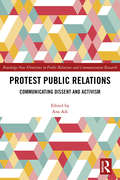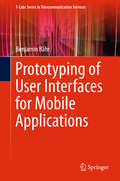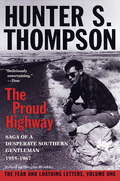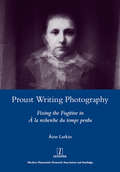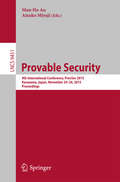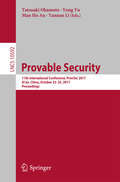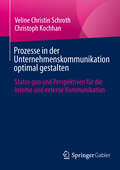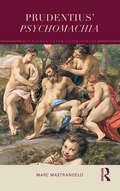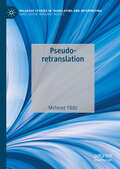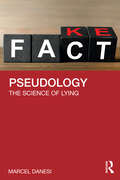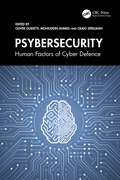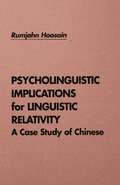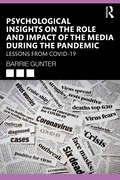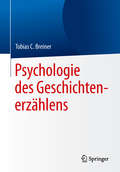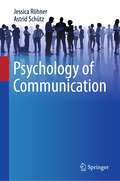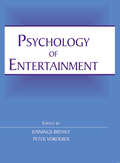- Table View
- List View
Prosodic Studies: Challenges and Prospects (Routledge Studies in Chinese Linguistics)
by Youyong Qian Hongming ZhangProsody is one of the core components of language and speech, indicating information about syntax, turn-taking in conversation, types of utterances, such as questions or statements, as well as speakers' attitudes and feelings. This edited volume takes studies in prosody on Asian languages as well as examples from other languages. It brings together the most recent research in the field and also charts the influence on such diverse fields as multimedia communication and SLA. Intended for a wide audience of linguists that includes neighbouring disciplines such as computational sciences, psycholinguists, and specialists in language acquisition, Prosodic Studies is also ideal for scholars and researchers working in intonation who want a complement of information on specifics.
Protecting Children Online?: Cyberbullying Policies of Social Media Companies (The Information Society Series)
by Tijana MilosevicA critical examination of efforts by social media companies—including Facebook, Twitter, Snapchat, and Instagram—to rein in cyberbullying by young users.High-profile cyberbullying cases often trigger exaggerated public concern about children's use of social media. Large companies like Facebook respond by pointing to their existing anti-bullying mechanisms or coordinate with nongovernmental organizations to organize anti-cyberbullying efforts. Do these attempts at self-regulation work? In this book, Tijana Milosevic examines the effectiveness of efforts by social media companies—including Facebook, Twitter, YouTube, Snapchat, and Instagram—to rein in cyberbullying by young users. Milosevic analyzes the anti-bullying policies of fourteen major social media companies, as recorded in companies' corporate documents, draws on interviews with company representatives and e-safety experts, and details the roles of nongovernmental organizations examining their ability to provide critical independent advice. She draws attention to lack of transparency in how companies handle bullying cases, emphasizing the need for a continuous independent evaluation of effectiveness of companies' mechanisms, especially from children's perspective. Milosevic argues that cyberbullying should be viewed in the context of children's rights and as part of the larger social problem of the culture of humiliation.Milosevic looks into five digital bullying cases related to suicides, examining the pressures on the social media companies involved, the nature of the public discussion, and subsequent government regulation that did not necessarily address the problem in a way that benefits children. She emphasizes the need not only for protection but also for participation and empowerment—for finding a way to protect the vulnerable while ensuring the child's right to participate in digital spaces.
Protecting Mobile Networks and Devices: Challenges and Solutions (Series in Security, Privacy and Trust)
by Steven Furnell Jianying Zhou Xiapu Luo Weizhi MengThis book gathers and analyzes the latest attacks, solutions, and trends in mobile networks. Its broad scope covers attacks and solutions related to mobile networks, mobile phone security, and wireless security. It examines the previous and emerging attacks and solutions in the mobile networking worlds, as well as other pertinent security issues. The many attack samples present the severity of this problem, while the delivered methodologies and countermeasures show how to build a truly secure mobile computing environment.
Protecting National Security: A History of British Communications Investigation Regulation
by Phil GloverThis book contends that modern concerns surrounding the UK State’s investigation of communications (and, more recently, data), whether at rest or in transit, are in fact nothing new. It evidences how, whether using common law, the Royal Prerogative, or statutes to provide a lawful basis for a state practice traceable to at least 1324, the underlying policy rationale has always been that first publicly articulated in Cromwell’s initial Postage Act 1657, namely the protection of British ‘national security’, broadly construed. It further illustrates how developments in communications technology led to Executive assumptions of relevant investigatory powers, administered in conditions of relative secrecy. In demonstrating the key role played throughout history by communications service providers, the book also charts how the evolution of the UK Intelligence Community, entry into the ‘UKUSA’ communications intelligence-sharing agreement 1946, and intelligence community advocacy all significantly influenced the era of arguably disingenuous statutory governance of communications investigation between 1984 and 2016. The book illustrates how the 2013 ‘Intelligence Shock’ triggered by publication of Edward Snowden’s unauthorized disclosures impelled a transition from Executive secrecy and statutory disingenuousness to a more consultative, candid Executive and a policy of ‘transparent secrecy’, now reflected in the Investigatory Powers Act 2016. What the book ultimately demonstrates is that this latest comprehensive statute, whilst welcome for its candour, represents only the latest manifestation of the British state’s policy of ensuring protection of national security by granting powers enabling investigative access to communications and data, in transit or at rest, irrespective of location.
Protecting the Dharma through Calligraphy in Tang China: A Study of the Ji Wang shengjiao xu 集王聖教序 The Preface to the Buddhist Scriptures Engraved on Stone in Wang Xizhi’s Collated Characters (Monumenta Serica Monograph Series)
by Pietro De LaurentisThis is a study of the earliest and finest collated inscription in the history of Chinese calligraphy, the Ji Wang shengjiao xu 集王聖教序 (Preface to the Sacred Teaching Scriptures Translated by Xuanzang in Wang Xizhi’s Collated Characters), which was erected on January 1, 673. The stele records the two texts written by the Tang emperors Taizong (599–649) and Gaozong (628–683) in honor of the monk Xuanzang (d. 664) and the Buddhist scripture Xin jing (Heart Sutra), collated in the semi-cursive characters of the great master of Chinese calligraphy, Wang Xizhi (303–361). It is thus a Buddhist inscription that combines Buddhist authority, political power, and artistic charm in one single monument. The present book reconstructs the multifaceted context in which the stele was devised, aiming at highlighting the specific role calligraphy played in the propagation and protection of Buddhism in medieval China.
Protest Nation: Words That Inspired a Century of American Radicalism
by Timothy Patrick McCarthy and John McMillianHistoric writings by socialists, LGBT activists, environmentalists, and more: &“An extraordinary collection of the voices of American dissidents.&” —Howard Zinn Protest Nation is a guide to the speeches, letters, broadsides, essays, and manifestos that form the backbone of the American radical tradition in the twentieth century. With examples from socialists, feminists, union organizers, civil-rights workers, gay and lesbian activists, and environmentalists that have served as beacons for millions, the volume also includes brief introductory essays by the editors that provide a rich biographical and historical context for each selection. Included are: *a fiery speech by socialist Eugene V. Debs *an astonishing treatise on animal liberation by Peter Singer *an excerpt from Silent Spring by Rachel Carson *Harvey Milk&’s &“The Hope Speech&” *the original Black Panther Party Platform *Peter Singer&’s astonishing treatise on animal liberation *plus writings from Upton Sinclair, Charlotte Perkins Gilman, Betty Friedan, Malcolm X, César Chávez, and more
Protest Public Relations: Communicating dissent and activism (Routledge New Directions in PR & Communication Research)
by Ana AdiGlobal movements and protests from the Arab Spring to the Occupy Movement have been attributed to growing access to social media, while without it, local causes like #bringbackourgirls and the ice bucket challenge may have otherwise remained unheard and unseen. Regardless of their nature – advocacy, activism, protest or dissent – and beyond the technological ability of digital and social media to connect support, these major events have all been the results of excellent communication and public relations. But PR remains seen only as the defender of corporate and capitalist interests, and therefore resistant to outside voices such as activists, NGOs, union members, protesters and whistle-blowers. Drawing on contributions from around the world to examine the concepts and practice of "activist," "protest" and "dissent" public relations, this book challenges this view. Using a range of international examples, it explores the changing nature of protest and its relationship with PR and provides a radical analysis of the communication strategies and tactics of social movements and activist groups and their campaigns. This thought-provoking collection will be of interest to researchers and advanced students of public relations, strategic communication, political science, politics, journalism, marketing, and advertising, and also to PR professionals in think tanks and NGOs.
Protest on the Page
by James L. Baughman Jennifer Ratner-Rosenhagen James P. DankyThe use of print to challenge prevailing ideas and conventions has a long history in American public life. As dissenters in America sought social change, they used print to document, articulate, and disseminate their ideas to others. Protest always begins on the margins, but print is the medium that allows it to reach a larger audience. In Protest on the Page, scholars in multiple disciplines offer ten original essays that examine protest print culture in America since 1865. They explore the surprising range of dissidents who enlisted print in their causes--from vegetarians and anarchists at the advent of the twentieth century, to midcentury evangelicals and tween comic book readers, to GIs and feminists in the 1970s-80s. Together they demonstrate that print has never been a neutral medium, but rather has been instrumental in shaping the substance of protest and its audiences.
Protocol Analysis: Verbal Reports as Data
by K. Anders Ericsson Herbert A. SimonVerbal data has been used increasingly to study cognitive processes in many areas of psychology, and concurrent and retrospective verbal reports are now generally accepted as important sources of data on subjects' cognitive processes in specific tasks.
Prototyping of User Interfaces for Mobile Applications (T-Labs Series in Telecommunication Services)
by Benjamin BährThis book investigates processes for the prototyping of user interfaces for mobile apps, and describes the development of new concepts and tools that can improve the prototype driven app development in the early stages. It presents the development and evaluation of a new requirements catalogue for prototyping mobile app tools that identifies the most important criteria such tools should meet at different prototype-development stages. This catalogue is not just a good point of orientation for designing new prototyping approaches, but also provides a set of metrics for a comparing the performance of alternative prototyping tools. In addition, the book discusses the development of Blended Prototyping, a new approach for prototyping user interfaces for mobile applications in the early and middle development stages, and presents the results of an evaluation of its performance, showing that it provides a tool for teamwork-oriented, creative prototyping of mobile apps in the early design stages.
Proud Highway: Saga of a Desperate Southern Gentleman, 1955-1967
by Hunter S. Thompson Douglas Brinkley William J. KennedyHere, for the first time, is the private and most intimate correspondence of one of America's most influential and incisive journalists--Hunter S. Thompson. In letters to a Who's Who of luminaries from Norman Mailer to Charles Kuralt, Tom Wolfe to Lyndon Johnson, William Styron to Joan Baez--not to mention his mother, the NRA, and a chain of newspaper editors--Thompson vividly catches the tenor of the times in 1960s America and channels it all through his own razor-sharp perspective. Passionate in their admiration, merciless in their scorn, and never anything less than fascinating, the dispatches of The Proud Highway offer an unprecedented and penetrating gaze into the evolution of the most outrageous raconteur/provocateur ever to assault a typewriter.
Proust Writing Photography: Fixing the Fugitive in A La Recherche Du Temps Perdu
by Aine LarkinThe importance of vision and visual arts such as painting, theatre, and sculpture in Marcel Proust's A la recherche du temps perdu has long been affirmed; another significant system of visual representation in the novel is photography. Proust appropriated photography as a practice with its own distinctive characteristics which could inform his writing about the processes of perception and memory. Through close textual analysis of scenes where photography is experienced or observed as a practice, and scenes where photography is written into the body of the text, Aine Larkin offers an invigorating new study that sheds genuinely new light on the presence of photographic motifs in Proust's novel, and the subtlety of Proust's engagement with this modern imaging system in his work.
Provable Security
by Man-Ho Au Atsuko MiyajiThis book constitutes the refereed proceedings of the 9th International Conference on Provable Security, ProvSec 2015, held in Kanazawa, Japan, in November 2015. The 19 full papers and 7 short papers presented together with 3 invited talks were carefully reviewed and selected from 60 submissions. The papers are grouped in topical sections on fundamental, protocol, authenticated encryption and key exchange, encryption and identification, privacy and cloud, leakage-resilient cryptography and lattice cryptography, signature and broadcast encryption.
Provable Security
by Yong Yu Tatsuaki Okamoto Man Ho Au Yannan LiThis book constitutes the refereed proceedings of the 11th International Conference on Provable Security, ProvSec 2017, held in Xi'an, China, in October 2017. The 24 full papers and 5 short papers presented were carefully reviewed and selected from 76 submissions. The papers are grouped in topical sections on secure cloud storage and computing; digital signature and authentication; authenticated encryption and key exchange; security models; lattice and post-quantum cryptography; public key encryption and signcryption; proxy re-encryption and functional encryption; protocols.
Prozesse in der Unternehmenskommunikation optimal gestalten: Status quo und Perspektiven für die interne und externe Kommunikation
by Christoph Kochhan Veline Christin SchrothDieses Buch untersucht die aktuellen Kommunikationsprozesse in Unternehmen und leitet daraus praktische Empfehlungen ab. Eine strategische Kommunikation, schlüssig auf die jeweiligen Zielgruppen ausgerichtet, spielt eine zentrale Rolle in Unternehmen: Botschaften müssen ihre Adressaten optimal erreichen und sinnvoll gesteuert werden, um positive Reaktionen zu erzeugen. Erfolgreiche Konzepte basieren auf klaren Kommunikationsstrukturen, die sowohl einen festen Rahmen als auch Flexibilität in den Prozessen ermöglichen. Die Autor*innen präsentieren Kommunikationsansätze und -bedingungen und haben durch leitfadengestützte Interviews den Status quo der Kommunikation in Unternehmen ermittelt. Die qualitativen Befragungen zeigen, welche Prozesse aktuell in der Unternehmenskommunikation unterschiedlicher Branchen angewendet werden, welche Rolle Künstliche Intelligenz dabei spielt und wie ein klar strukturierter Kommunikationsansatz, wie z.B. ein Corporate Newsroom, die Basis dafür bilden kann. Extra: Umfangreiches Interview mit dem Experten für Unternehmenskommunikation Thomas Mickeleit, der Praxistipps und Empfehlungen gibt.
Prudentius’ Psychomachia (Routledge Later Latin Poetry)
by Marc MastrangeloThis new translation brings to life Prudentius' Psychomachia, one of the most widely read poems in western Europe from Late Antiquity through the Renaissance. With accompanying notes and introduction, this volume provides a fresh exploration of its themes and influence. The Psychomachia of Prudentius (348–c. 405), an allegorical epic poem of nearly 1,000 lines about the battle between the virtues and the vices for possession of the human soul, led early modern scholars to refer to the late antique poet as "the Christian Vergil." Combining depictions of violent, single combats with allusions to pagan epic poetry, biblical scenes, and Christian doctrine, the poem captures the dynamism of the later Roman Empire in which the pagan world was giving way to a new, Christian Europe. In this volume, the introduction sets the historical and literary context and illuminates the Psychomachia’s prominent role in western literary history. Mastrangelo’s translation aims to capture the rhetorical power of the author’s Roman Christian Latin for the 21st-century reader. The notes provide the reader with in-depth information on Prudentius’ Latinity, the Roman epic tradition, and Christian doctrine. This volume is directed at students and scholars across the disciplines of comparative literature, classics, religion, and ancient and medieval studies, as well as any reader interested in the history and development of literature in the West.
Pseudo-retranslation (Palgrave Studies in Translating and Interpreting)
by Mehmet YildizThis book presents pseudo-retranslations as a new phenomenon of translational intertextuality, revealing how pseudo-retranslations establish large networks of intertextuality across academic works, how academic authors have recourse to this procedure as they create their academic texts, and how pseudo-retranslations contribute to the dissemination of translation-distorted scholarly knowledge and lead to epistemically polluted academic ecosystems. Pseudo-retranslation can be defined as an academic author’s partial or complete exploitation of another academic author’s translation and presenting it as a retranslation of the source text. This phenomenon, first documented in Yildiz (2021), arises from academic authors’ failure to refer to or translate primary sources – particularly in English. Since there occurs no actual retranslation process, this procedure is called pseudo-retranslation. Using a range of academic texts from the Turkish context as case studies, the author presents the integral constituents of this phenomenon, and the behavioural patterns of its renderers. This book will be of particular interest to academics and postgraduates in the field of translation studies and (corpus) linguistics.
Pseudology: The Science of Lying
by Marcel DanesiIn an age where fake news, conspiracy theories, and outright lies by political and cultural leaders are commonplace, we may be becoming accustomed to lying, or worse, even immune to it. Pseudology unravels the reasons for this by describing a “science of lying” that looks at various aspects of this trait, from how it affects the brain to how it distorts perception.Interest in lying goes back to antiquity and writing and debate has only increased in the present day, but what is missing is a treatment that synthesizes the work from linguists, political scientists, anthropologists, psychologists, neuroscientists, and sociologists, tying them to the philosophical and literary views of lying throughout history. Such a treatment can be called "pseudology": an interdisciplinary science for classifying, collating, and assessing ideas about lying. This book is a comprehensive treatment of pseudology, emphasising the importance of studying lying in our current climate. Pseudology addresses questions such as:• What is a lie?• Why do we lie?• Why are we so susceptible to lying?• How does lying activate false beliefs and generate hatred of others?• How has lying shaped the course of history (at least to some extent)?• How has lying been adopted as a basic thematic element in literature and the arts?Synthesising research from a broad range of disciplines and from the perspective of a leading cognitive linguist, this text weaves ideas and theories about lying cohesively into an overall interdisciplinary science. This landmark book is vital for students and scholars of language as well as anyone interested in politics, sociology, or psychology.
Psybersecurity: Human Factors of Cyber Defence
by Mohiuddin Ahmed Craig Speelman Oliver GuidettiPsybersecurity: Human Factors of Cyber Defence is a clarion call to action in the face of a stark reality: over 90% of cyberattacks exploit human vulnerabilities, as highlighted by the 2022 Global Risks Report from the World Economic Forum. This gap between the rapid advancement of cyber security technologies and the slower pace of development in human-centric defences poses a formidable challenge to national security and personal safety. Amidst the dazzling progress of AI technologies like ChatGPT and Microsoft Security Co-Pilot, the human element of cyber security remains critically underdeveloped.Set against the backdrop of the Australian government's ambitious goal to become the world's most cybersecure nation by 2030, this book embarks on a mission to address the overlooked human factors in cyber defence. It advocates for a balanced approach that not only relies on technological advancements but also significantly enhances the human aspects of cyber security.Through an interdisciplinary exploration, Psybersecurity delves into how cyberthreats exploit human vulnerabilities and offers innovative solutions for building resilience against these vulnerabilities. It examines the necessity for cyber security strategies that encompass psychological insights, systemic resilience, and the mitigation of human errors, particularly within critical infrastructures and cyber-physical systems (CPS).Furthermore, this work critiques existing cyber security education frameworks, proposing a comprehensive curriculum that equips individuals with technical skills and the behavioural competencies needed to navigate the cyber landscape ethically and effectively. It also addresses AI's ethical dilemmas and psychological impacts, offering a forward-looking perspective on combating AI-driven harassment and endorsing a new field of study: "Psybersecurity."Psybersecurity: Human Factors of Cyber Defence aims to bridge the gap between cyber security and human sciences, ignite a transformation in understanding, and fortify our digital world. It is an essential read for academics, professionals, and anyone committed to building a safer, more resilient cyber future in alignment with Australia's 2030 vision.
Psycholinguistic Implications for Linguistic Relativity: A Case Study of Chinese
by Rumjahn HoosainRather than offering variations in "world view" as evidence for linguistic relativity, this book views language related differences in terms of the facility with which information is processed. Distinctive perceptual, memory, and neurolinguistic aspects of the Chinese language are discussed, as is the cognitive style of the Chinese people. Chinese orthography and other features of morphology and syntax are examined in relation to both bottom-up and top-down cognitive processes. While providing an extensive review of the experimental literature published in English on the Chinese language, this volume also offers a significant sample of the literature originally published in Chinese.
Psychological Insights on the Role and Impact of the Media During the Pandemic: Lessons from COVID-19
by Barrie GunterThis volume places the spotlight on the role different media and communications systems played in informing the public about the pandemic, shaping their views about what was happening and contributing to behavioural compliances with pandemic-related restrictions. Throughout the pandemic, media coverage has played an important role in drawing attention to specific messages, influencing public risk perceptions and fear responses. Mainstream media and other electronic communication systems such as Facebook and WhatsApp have been pivotal in getting pandemic information out to the public, thereby influencing their beliefs, attitudes and behaviour and engaging them generally in the pandemic as stakeholders. In this timely volume, author Barrie Gunter considers how people reacted to this coverage and its contribution to their understanding of what was going on, including the influence of fake news and misinformation on public beliefs about the pandemic, from anti-lockdown protests to the "anti-vaxx" movement. In addition, looking at how government messaging was not always consistent or clear and how different authorities were found not always to be in harmony or compliance with the messages they put out, Gunter examines the harm done by presenting different publics with ambiguous or conflicting narratives. Drawing out important communications strategy lessons to be learned for the future, this is essential reading for students and researchers in psychology, public health and medical sciences and for policymakers who assess government strategies, responses and performance.
Psychological Warfare in the Arab-Israeli Conflict
by Ron SchleiferThe first study to examine psychological warfare in the context of the Arab-Israeli conflict, this book presents a rational analysis of the Arab and Israeli struggles to gain the world's sympathy and support, tracing these struggles from the British Mandate to the more recent HAMAS abduction of IDF soldier Gilad Shalit.
Psychologie des Geschichtenerzählens
by Tobias C. BreinerIn diesem Buch geht es um die Psychologie guter Geschichten und deren Handlungsfiguren. Es beantwortet Fragen wie:Warum rühren uns manche Filme zu Tränen und andere lassen uns kalt?Warum fesseln uns manche Romane so, dass wir bis tief in die Nacht weiterlesen? Warum quälen wir uns dagegen durch manche Pflichtlektüre hindurch?Warum zocken wir manches Adventure-Game bis zum letzten Level während wir bei anderen schnell die Lust verlieren? Das Werk ist für all diejenigen verfasst, die sich in irgendeiner Weise mit der Erzeugung und Bewertung von Handlungen befassen. Sowohl Charakter- und Game-Designer profitieren durch neue archetypische Modelle und Psychologen können mit der hier präsentierten dodekazyklischen Heldenreise innovative therapeutische Methoden entwickeln. Roman- und Drehbuchautoren bekommen eine Blaupause für erfolgsversprechende Geschichten, die sich auch auf das Interactive Storytelling übertragen lässt und Regisseure sowie Film-, Computerspiel- und Literaturkritiker erhalten durch den Inhalt des Werkes gezielte Bewertungskriterien.
Psychology of Communication
by Jessica Röhner Astrid SchützThis successful textbook on the psychology of communication explains - here in English for the first time - how human communication works in a very understandable way. It begins with the explanation of central terms and the explanation of known communication models (e.g. the models according to Schulz von Thun, Watzlawick, Hargie and colleagues), then describes means of non-verbal and verbal communication and ends with a clear and structured summary of communication forms. Concrete fields of application, stumbling blocks (e.g. intercultural differences in communication), practical examples and digressions in the book round off what has been read and consolidate what has been learned. In addition, free learning materials are available on the Internet with which readers can test their knowledge acquisition.
Psychology of Entertainment: The Psychology Of Its Appeal (Routledge Communication Series)
by Jennings Bryant Peter VordererAs entertainment becomes a trillion-dollar-a-year industry worldwide, as our modern era increasingly lives up to its label of the "entertainment age," and as economists begin to recognize that entertainment has become the driving force of the new world economy, it is safe to say that scholars are beginning to take entertainment seriously. The scholarly spin on entertainment has been manifested in traditional ways, as well as innovative ones. Representing the current state of theory and research, Psychology of Entertainment promises to be the most comprehensive and up-to-date volume on entertainment. It serves to define the new area of study and provides a theoretical spin for future work in the area.Divided into three basic parts, this book:*addresses the fundamental mechanisms and processes involved in orienting to and selecting entertainment fare, as well as receiving and processing it;*explores the mechanisms and processes by which we are entertained by the media messages we select and receive; and*provides an opportunity for the application of well-established as well as emerging psychological and psychobiological theories to be applied to the study of entertainment in ways that seldom have been utilized previously.Psychology of Entertainment will appeal to scholars, researchers, and graduate students in media studies and mass communication, psychology, marketing, and other areas contributing to the entertainment studies area.
